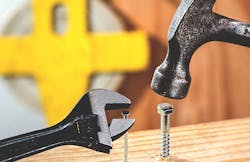Last month, I continued discussing the steps we took to drastically reduce the number of vehicles that we needed to order another part for once the vehicle was in production. The first step was preparing our team for changes. For a lot of technicians, there is comfort in familiarity and fear in change. The second step was keeping score. I outlined that we started keeping score after we disassembled the vehicle, ordered all the parts, and mirror matched those parts once they arrived. After that moment, we then keep score. If the vehicle needs another part, it is considered a failure. That word “failure” leads me into another step on our journey.
Our team had a very tough time with labeling a job as a failure, or fail. They took the word “failure” very personally. Whenever I attend a conference, there are always people who ask the question, “How do we change the culture of our shop?” One thing that lets all of us know when we are in a different culture is the language. If you’ve ever visited another country, you most likely immediately noticed the difference in language. It is so easy to tell you are in a different culture by the language. Even if you visit another part of the U.S., you might hear words pronounced differently. If you order a sandwich, you might order a hero, hoagie, sub, or grinder, depending on your geographic location. When we make big changes to our process, we always change the terminology we use. It is a constant reminder that we are now changing our culture. For example, before we used to “receive” parts. Now when parts arrive at our shop, we “mirror match” them. While it may seem rather simple, it is a constant reminder that we are now doing something different.
Using the new terms that we develop continues to reinforce the new behavior we discussed as a group. We have used many different terms to disassemble a vehicle. Every time we change direction in how we take vehicles apart, we rename the process. It has been called damage analysis, mapping, blueprinting, and so on. However, everyone in the shop calls it the same thing. The language we speak helps shape our culture.
Another step that is critical in every department of our company is creating and sustaining processes. I can honestly say our business wouldn’t be profitable if we didn’t have all our processes we’ve put into place. We have implemented many processes in our shop that have helped us get all the parts needed for each vehicle upfront. One of the processes that stands out is separating the parts that are for R&I and the parts that need to be replaced. When we take the parts off the vehicle, we put them in two distinct areas: one area is all the parts that will be going back on the vehicle after it’s painted (such as door handles, belt mldgs, etc.) and the other area is for all the parts we need to order. As we write the complete estimate, we move each part that needs to be ordered out of the area for replacement so that we are certain we touched each one. This might seem like a simple process. However, it has paid extraordinary dividends.
Another process we put into place is having a separate technician review the parts cart that contains all the parts we removed from the vehicle only for R&I. The techs have openly commented on how valuable that process is and were surprised at how many parts we found that actually needed to be replaced during that review. We do this part of the process before we order parts; that way, if we find a bracket that has a missing tab, we don’t have to place a second parts order just for that bracket. We also don’t find that out when we put the vehicle back together anymore, which is the exact thing we want to avoid.
While processes have helped us reduce the amount of vehicles that needed another part, they have numerous other benefits, too. The daily stress level is reduced significantly when everyone operates in the same way. Training someone new or having someone cover for a teammate on vacation is much easier when we have existing processes. To use the example from earlier, the chances of something getting lost in translation is reduced greatly when we understand the same language. And, perhaps more significantly for me as a leader, it becomes extremely easy to pick out the person not from the local area (or in the case of a shop, the person who isn’t on board with the culture shift) when he or she doesn’t speak the same language.
